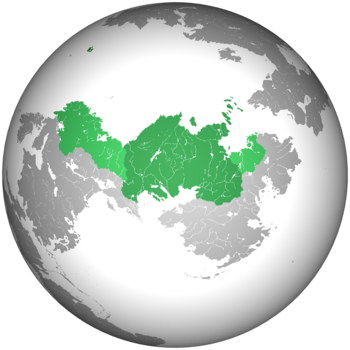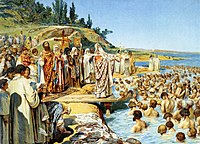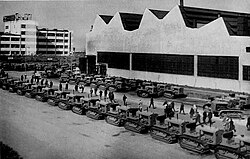Letnia
This article or section is in the process of an expansion or major restructuring. You are welcome to assist in its construction by editing it as well. If this article or section has not been edited in several days, please remove this template. If you are the editor who added this template and you are actively editing, please be sure to replace this template with {{in use}} during the active editing session. Click on the link for template parameters to use.
This article was last edited by HackKnee (talk | contribs) 5 years ago. (Update timer) |
Letnian Empire Летная империя | |
|---|---|
| Motto: "объединены как один под Богом" (Russian) "United as one under God" | |
| Anthem: "Прощание славянки " (Russian) "Farewell of Slavianka" | |
 Map of Letnia on a Globe of Septentrion | |
| Capital | Turov |
| Official languages | Letnian, Kalvian |
| Recognised regional languages | Razakh, Erquinian, Chervakian |
| Ethnic groups (2016) | Letnian (62%), Kalvian (21%), Razani (7%), Chervakian (2%), Rodavian (4%), other (4%) |
| Demonym(s) | Letnian |
| Government | Communism Meritocracy |
• Chairman of the Central Party | Vetrov Borisovich Zhukov |
| Area | |
• Total Land | 4,514,974 km2 (1,743,241 sq mi) (1) |
• Water (%) | 2.81% |
| Population | |
• 2018 estimate | 181,610,000 |
• Density | 40.22/km2 (104.2/sq mi) |
| GDP (PPP) | 2017 estimate |
• Total | $4,336,250,000 (5) |
• Per capita | $23,876 (21) |
| GDP (nominal) | 2017 estimate |
• Total | $3,617,870,000 (6) |
• Per capita | $19,917 (24) |
| Gini (2017) | 19.5 low (15) |
| HDI (2017) | very high (9) |
| Currency | рубль (ruble) (RBL) |
| Time zone | UTC+5 (Turov Mean Time [TMT]) |
| Date format | dd-mm-yyyy |
| Driving side | left |
| Calling code | +27 |
| Internet TLD | .web ; .cs ; .ltv ; |
Letnia (Letnian: Летния), officially the Letnian Empire (Letnian: Летная империя, tr. Letnaya Imperiya), is a State existing on the continent of Casaterra in the region of Septentrion. A union of multiple national republics, it's government and economy are highly centralized. The Empire has two large self-governed dependencies, the principality of Kolodiya and the principality of Beloslavia. The Empire is a Constitutional Monarchy, ruled by the Tsar in the capital of Turov.
Letnia has an estimated population of over 318 million people, with more than 30 ethnic groups being represented. The vast majority of the country identifies as ethnically Letnian, with 62% of the country claiming Letnianas their ethnicity in the 2016 census. The majority of the population lives in the south, where cold weather is less threatening and crops can more easily grow. Nearly 12 million people live in the capital city of Turov, making it one of the largest cities in Septentrion and the largest on Casaterra.
Letnia is considered by many to be a Regional Power, and is one of the states allowed in the STAPNA to keep it's nuclear arsenal. Letnia is a dominant military power, with the second highest military spending in Casaterra and the fifth highest in Septentrion.
Etymology
The name Letnia is derived from Let', a medieval state in Casaterra mostly populated by Northern Slavs. However, this proper name became more prominent in later history, when historians denoted the state by this name to separate it from the later Letnian state. However, most of the inhabitants of the early Let' referred to themselves as "Летная Земля" (Letnaya zemlja), which can be roughly translated as "Letnian Land" or "Land of the Let".
The standard way to refer to citizens of Letnia is "Letnians" in Tyran, and "Летневияне" in Letnia . There are two Letnian words which can translate into "Letnian". One is "Летние" (Letniye) and translates to "ethnic Letnian". The other is "Летнияне" (Letniyane), which translates to citizens of Letnia, regardless of ethnic background. Translations often do not distinguish between the two, while in the language and culture the difference is quite important.
History
Early History
The first Slavic states are recorded as forming on Casaterra in the early 7th century. Before this time, there is little evidence of activity in North Casaterra. Archaeological finds indicate that settlements began in the Turov region as early as 120 B.C, but there are few records of such peoples. Eisen records speak of harsh steppe-people to their north, but rarely elaborate. Regardless, confederations of city-states existing in Northern Casaterra roughly around the beginning of the 7th century. States formed quickly and in chaos amid invasions of the Eisen peoples, and soon covered much of the Northern Casaterran landscape.
Kirovian Let'
The largest and most prominent early Slavic state in Casaterra formed as early as the 9th century. The state, known now as the Kirovian Let', consisted of much of the area around modern Kirov, all the way along the coast near modern Eisenmaat. It was formed by a prominent man from the Let' people, who conquered the Slavic city-state of Kirov, who had been tribute to Tatars of the steppe region. The territory of the Kirovian Let' grew, expanding to much of the coast of modern day Letnia. The Prince Vladimir the Wise of Kirov accepted Orthodox Christianity in 1028, also creating the first Slavic legal code in his reign.
In the following centuries, the Kirovian Let' became one of the largest and richest states in Casaterra. However, the age of feudalism and decentralization marked the end of the Kirovian Let', which became consumed with infighting among petty nobles. Ultimately the Let' disintegrated in the early 13th century with the great Tatar invasions of 1212 and 1231. The duchies of Turov and Kirov formed from the ashes of the Let' in modern Letnia and Kalvia, and the Kingdom of Augustow formed in modern Erquin, pushing out the Eisen in the area.
Grand Duchy of Turov (1273-1550)
Over time, the Duchy of Turov quickly expanded. In 1273, Turov defeated it's rival, Kirov, and marched into it's capital. Turov was declared to be a "Grand Duchy", and a series of reforms was instituted by Prince Yuri I to more effectively govern the Duchy. Times remained difficult and skirmishes were frequent with neighbors, but slowly the Duchy began to assert influence over all of central-north Casaterra.
Conflicts with the Slavic peoples of nearby Volduria grew in the late 14th century, with borders constantly shifting and border areas being razed frequently. Agriculture suffered greatly as a result of the Little Ice Age. In 1304, tensions with the Eisen to the south came to a head as well. A crusade made up of Eisen and some Sylvan troops moved to forcefully convert their northern and "backwards" neighbor to agree with some issues of theological debate in the Christian world. This "Great Northern Crusade" made initial gains, but was ultimately crushed during the battle of Katlyn River in 1305. Over time after this, the Duchy of Turov gradually began to eat away at nearby territories, growing by absorbing nearby rivals. Modern day Kalvia was fully annexed in the 1440s, when Turovian troops beheaded the Prince of Kalvia after the eight month Siege of Svorysk in 1443.
Tsardom of Letnia (1550-1704)
In roughly 1545, the ___ Empire completely collapsed. The Catholic center of the world fell into Protestant hands. This left Turov as the foremost protector of Eastern Apostolic Christianity. In order to reflect this new status, Prince Dmitry Romanovich ("The Terrible") crowned himself Tsar ("Caesar") of the Let' peoples, or Letnia. During his long reign, Dmitry II centralized power of the Tsardom and increased the size of the empire by almost 45%, subjugating modern Cherniya and Volduria, as well as part of northern Maldania. By the end of the 16th century, Letnia was a multicultural, multinational nation that comprised over 60% of North Casaterra's population. It's relatively defend-able geography kept it safe from attacks from the south, save minor wars with Jedoria and Eisenmaat. The Cherniyan Republic was fully conquered in the late 16th century, resulting in a massive swath of new farmlands becoming available. This was a period of relative stability and internal growth, with a series of good rulers and excellent administration resulting in above average crop yields.
Imperial Letnia (1704-1902)
In 1704, Czar Michael I declared Letnia an Empire. In 1734, tensions erupted between the Kerenevoian Empire and the Letnian Empire over what Church those in Sebrenskiya belonged to, resulting in a 5 year war between Letnia and Kerenevoi. After 5 years of brutal fighting on a narrow strip of land in South Sebrenskiya, Letnia declared victory and forcefully instated Eastern Apostolic Christianity in Southern Sebrenskiya. During this period, the city of Turov was extremely important as both the administrative center of Letnia and the center of Eastern Apostolic Christianity. This period was stable economically, but was turbulent politically as there were multiple wars with outside forces and between the Czar and Church. The Letnian-Erquinian War began in 1821, and resulted in Beloslavia becoming a principality owing allegiance directly to the Letnian crown. Tsarina Elizabeth II tried to remove the Patriarchate from the Church in 1846 after an argument between her and the Patriarch, resulting in mass protests and the reversal of her decision.
After the death of Alexander II in 1885, people began to lose their trust in the Czars follow a perceived usurpation of power from the church and lack of interest in the plights of the common man. This belief, coupled with stifled intellectual movements, resulted in various socialist and republican movements in Letnia- which ultimately collided in the bitter years of 1900-1906.
Modern Period (1902-present)
Dissent and Bloody Sunday (1900-1906)
Following the failure and great loss of life in the famines and Kolodiyan War of 1896, tensions rose dramatically in the empire. Returning soldiers returned to find their farms destroyed or desolate, with many grieving the ones that didn't come back. It was during this period that the nobility and common citizens of the empire alike began to grumble about the government. Following "Bloody Sunday", where tsarist troops shot a number of innocent protesters, Tsar Ivan IV, under immense pressure from nobles and even his own family, abdicated the throne on February 23rd, 1904. His son Vladimir I proved to be both incredibly popular and effective in his early reign, creating a state duma and allowing local assemblies to have more power to govern their local areas.
Reform Era (1906-1937)
The shaken country under the new Tsar quickly moved to rejuvenate the ailing economy. Initial attempts to secure loans from southern Casaterra fell through, but the country's new ally in the Erquinian Commonwealth was willing to provide some light material aid and loans. The Tsar quickly and controversially sacked a number of his advisers and cabinet members, choosing instead some from outside the nobility. While rich merchant Dmitry Korotayev had fallen out of favor with the previous Tsar, his economic plans for agricultural growth were selected.
Industry, as in the before era of the Letnian Empire, was considered a top priority by the new leadership. Foreign specialists were brought in, loans taken for machinery and industrial equipment, and peasants coerced into a new national spirit of "work, nation, and faith" that was swelling among the slowly growing cities. While efficiency still lagged behind many Southern countries, visiting Erquinian and Eisen Specialists often spoke and wrote of a new "Letnian Industrialization". Chervak diplomat and writer Jan Čapek famously remarked that "the poor, uneducated peasant folk of Letnia, with their dedication and discipline in the factory, are worth three of our urban workers each." Foreign workers and specialists from many countries and backgrounds, enamored by lucrative offers by the government, moved to the Empire throughout the 1910s.
In 1917, the Erquinian Commonwealth declared war on the Ostlandian empire. While wholly unprepared for war, the Letnian government quickly promised to aid the Erquinians, hoping to repay the Commonwealth for assistance given during the Kolodiyan War. Despite never sending an army to the front, the Empire was a major source of weapons for the northern front- over two million small arms were shipped from the Tsardom to the Commonwealth over the course of the war, with a large amount of other material aid also being provided. Eventually the Empire did send an expeditionary force to the northern front, who eventually numbered almost 10,000 by the end of the war.
The interwar years of the Empire are best characterized by rapid industrialization and militarization of the workforce. The states capitalist policies were advertised as a much more democratic form of economics than under the previous structure, but in reality only offered nominal democracy at lower levels of agriculture and industry. Despite this, the state rapidly modernized the agricultural and industrial capacity of the nation, closing the gap between itself and Southern Casaterra significantly by the late 30s. Military capacity was a priority, especially given the clearly militant intentions of the nearby Ostland, and fears that under Fascist leader Hanz Adler war was imminent in Casaterra. A brief border skirmish between the Letnian Empire and Eisenmaat occurred in late 1937, resulting in a decisive Letnian victory. Eisen and Letnian borders remained a matter of dispute for the next two years, finally being redrawn with the treaty of Gretnz-Arsk in 1939.
War in Casaterra and Vinya (1938-1945)
Pan-Septentrion War (1938-1945)
The Pan-Septentrion War began in northern Casaterra in ___ 1938, when the Ostlandian Reich invaded the Vihoslav Commonwealth. Tsarina Katerina I, while refusing the join the war outright due to ongoing escalations in the West with Jedoria, began an immediate aid program to assist the Vihoslav state.
Northern War (1938-1945)
Tensions with the Jedorian Confederation had been running high since 1934, when Letnia claimed territory owned by Jedoria. The territory in question formerly belonged to the Cherniyan Republic, a puppet state of the Letnian Empire.
The Northern War began in 11 April 1940 when Letnia invaded Jedoria.
Postwar Era (1945-1985)
Modern Era (1985-Modern Day)
Geography
Letnia has a landmass of 4,514,973 square kilometers (1,743,240 square miles). It is the largest country in Septentrion. The Empire has a wide natural resource base, including major deposits of timber, petroleum, natural gas, coal, ores and other mineral resources. Letnia is believed to control many of the largest mineral deposits in the world, but the estimates vary due to much of the resources being locked in the hostile, cold north. It is the coldest country in Casaterra and the second coldest country in Septentrion, with much of it's northern territory frozen over.
Most of the area of the Empire consists of vast stretches of plains that are predominantly steppe to the south and heavily forested to the north, with mixed tundra and ice caps along the northern coast. The Southeast is much more temperate, with access to warm water in the Westgulf. There are numerous mountain ranges across the Empire, with the largest two being the Berkut Range in the northwest and the Opekun Mountain in the southeast. The Empire has an extensive coastline; most of it's northern coast is covered in ice year-round while it's southern coast consists of warmer water flowing from the Meridian Ocean. Although Letnia owns roughly 6% of Septentrion's arable land, much of the land in the north is unfit for farming due to cold temperatures and ice storms.
Northern Letnia is known for it's harsh blizzards, often referred to in other countries as "whiteouts". These harsh storms are famous for often killing unprepared citizens or tourists. Precipitation in the middle and lower parts of Letnia is much milder, with the lower portions of the Empire receiving a fair amount of rain in summer months. The central area of Letnia is fairly dry, with occasional snowfall throughout the year.
Climate
Due to the majority of Letnia's landmass being far north, the vast majority of the country is considered to be subarctic climate. Winters are severe, with temperatures averaging −30 °C in the northern subarctic and -5 °C in the southern side during the long winter. In the relatively short summer, temperatures can exceed 30 °C in the southern subarctic.
In the south, the very edge of the country is considered to be of the humid continental climate. This is the most densely populated area of Letnia. This is the only part of the Empire to receive a large portion of it's precipitation from liquid rain, and is kept at moderate temperatures year-wide by the Westgulf.
Far north lies the area classified as polar climate. Every month in the north has an average temperature of less than 10 °C, and has no warm summer. There are very few living organisms this far north, as it is too cold for many kids of trees and plants. The far north is covered in ice caps, and ice accumulates year round there. Any cities this far north are sparsely populated and mainly centers of administration, scientific research, and mining or drilling expeditions.
Government & Politics
Governance
Main Article: Government Of Letnia
Administrative divisions
Main Article: Administrative Divisions of Letnia
Foreign affairs
Main Article: — Foreign_Relations_of_Letnia See also: — Central_Intelligence_Directorate_of_Letnia
Military
See also: — Letnian Army
The Letnian military is divided into the Army, Navy, and Air Force. There are also three independent arms of service: Strategic Missile Troops, Space Forces, and the Airborne Troops.
In 2009, the military had just under 4 million personnel on active duty, not counting internal forces which consist of roughly half a million troops according to many estimates. It is mandatory for all male citizens aged 18–27 to be drafted for one and a half years of service in Armed Forces or two years in civil service, depending on their importance to the economy.
Letnia has the largest stockpile of nuclear arms in Septentrion, the largest tank force, and the largest air force. The Empire maintains the third largest navy in the world, and the most ballistic missile submarines.
Letnia has a very large domestic arms industry. It produces nearly all of it's equipment, bar a handful of imports from close allies. Unofficial estimates place Letnia as Septentrion's top weapons exporter 2007-2014, controlling over 33% of the market.
Economy
The economy of Letnia is varied. The primary sector is very large, consisting of mostly natural gas, mining, lumber, and oil. Letnia has the largest reserves of natural gas in Casaterra, and is the largest importer. Agriculture, while historically large in the country, has become secondary to industry since the industrialization efforts of the 1920s and 1930s.
The Letnian arms industry accounts for nearly 20% of industry, and Letnia is the largest supplier of weapons in the world. The largest manufacturer, Nikonov Concern, produces 90% of the small arms in the Tsardom and accounts for nearly 15% of small arms worldwide. The Tsardom is also a primary supplier of many other military goods, such as Main Battle Tanks (MBTs), armored vehicles, air defense, and aircraft. The Letnian aviation industry is one of the largest in Septentrion, offering a large number of internationally successful planes in both the military and civilian markets.
While lacking on the global market, the Letnian electronics industry has seen major growth in the last decade. Alongside the electronics industry, the IT industry has experienced a serious boom in the 2000s. The IT industry in Letnia is the second largest in Septentrion, and accounts for 8% of the software development market.
Energy
The electricity generation sector in Letnia is largely fossil-fuel–based. Many power plants nationwide use the nation's position as a major Cassaterran exporter of natural gas to their advantage by continuing to use natural gas as the primary raw material in production of their energy.
Renewable forms of energy account for a small proportion of Letnia's full energy generation capacity. However, the federal government has set targets for the development of renewable energy sources in Letnia which should see the power produced by renewable resources climb to 25% by 2020. This is to be achieved mainly through the construction of wind farms and a number of hydroelectric stations.
Transport
Travel in Letnia is made up of road, rail, and air travel. The country has spent upwards of 200 Billion rubles since 1986 to improve, maintain, and create new transport and infrastructure.
In 2014, the nation had 38,578 miles of railway track and 221,367 miles of highway. The first bullet train became operational in the Turov region in 1999. There are 15 airports in Letnia that serve commercial traffic, and many more private airports and military airbases. Letnia Airlines, formed in 1929, is the second oldest airline still operational in Septentrion, and flies to almost every country in the region.
Science and Technology
Culture
Cuisine
There are over 50 different ethnic groups and peoples in the Letnian Empire. The Empire's vast cultural diversity spans ethnic Letnians and Kalvians with their Slavic Orthodox traditions, Kazakhs with their steppe culture, Shamanistic peoples of the Extreme North and West, and central Slavs of the southeast.
Letnian cuisine widely uses fish, poultry, mushrooms, berries, and honey. Crops of rye, wheat, barley, and millet provide the ingredients for various breads, pancakes and cereals, as well as for kvass, beer and vodka drinks. Black bread is much more popular in Letnia than in Southern Casaterra. Flavorful soups, which play an important role in meals, include shchi, borsch, ukha, solyanka and okroshka. Smetana (a heavy sour cream) is often added to soups and salads. Pirozhki, blini and syrniki are native types of pancakes. Chicken Kirov is a very popular meat dish. Much meat in Letnian cuisine is cooked into soups and porridge or in dough.
Popular drinks include vodka, kvass, and tea. Vodka is the most popular alcoholic drink locally and the most famous of across Septentrion, and is often associated with the Tsardom and those of Letnian ethnicity. Tea is a very popular non-alcoholic drink nationally, with coffee less popular than the rest of Casaterra. Kvass is a well known non-alcoholic drink that is created from a fermented mixture of water, flour and liquid malt.
Architecture
Letnian architecture has it's roots deep in tradition and Orthodox belief. Early churches were the first great architectural achievements of the early northern Slavic peoples, and are famous across Septentrion for their colorful domes. With the weak economy in the late 1890s, many cities had poor building quality and little style. However, Following the post war period older church architecture and new architectural styles flourished as the economy stabilized.
Art
The Letnian Academy of Arts was created in 1762 and gave Letnian artists an international role and status. Many 18th century academicians and artists mostly focused on portrait painting. In the early 19th century, when neoclassicism and romantism flourished in Southern Casaterra, mythological and Biblical themes inspired many prominent paintings.
In the late-19th century a group of artists broke with the Academy and initiated a school of art liberated from academic restrictions. These were mostly realist painters who captured Letnian identity in landscapes of wide rivers, forests, and pine clearings, as well as vigorous genre scenes and robust portraits of their contemporaries. Some artists focused on depicting dramatic moments in history, while others turned to social criticism, showing the conditions of the poor and caricaturing authority.
Letnian art produced works that were furiously patriotic, anti-fascist, and anti-Pagan during and after the Pan-Septentrion War. Multiple war memorials, marked by a great restrained solemnity, were built throughout the country. Letnian artists often combined innovation with realism. Letnian artwork is often seen by the public through various propaganda outlets, such as posters and electronic media.
















